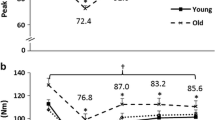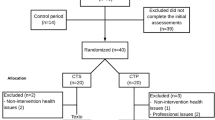Abstract
Purpose
The adaptations induced by endurance training on the neuromuscular function remain under investigation and, for methodological reasons, unclear. This study investigates the effects of cycling training on neuromuscular fatigue and its peripheral contribution measured during and immediately after cycling exercise.
Methods
Fourteen healthy men performed a fatigue test before a 9-week cycling program (PRE) and two tests after training: at the same absolute power output as PRE (POSTABS) and based on the post-training maximal aerobic power (POSTREL). Throughout the tests and at exhaustion (EXH), maximal voluntary contraction (MVC) and peripheral fatigue were assessed in the quadriceps muscle by electrical nerve stimulation [single twitch (Pt); high-frequency doublet (Db100) and low-to-high-frequency ratio (Db10:100)].
Results
Time to EXH was longer in POSTABS than PRE (34 ± 5 vs. 27 ± 4 min, P < 0.001), and POSTREL tended to be longer than PRE (30 ± 6 min, P = 0.053). MVC and peripheral fatigue were overall less depressed in POSTABS than PRE at isotime. At EXH, MVC and Db10:100 were similarly reduced in all sessions (–37 to − 42% and − 30 to − 37%, respectively). Db100 tended to be less depressed in POSTABS than PRE (–40 ± 9 vs. − 48 ± 16%, P = 0.050) and in POSTREL than PRE (–39 ± 9%, P = 0.071). Pt decreased similarly in POSTABS and PRE (–52 ± 16 vs. − 54 ± 16%), but POSTREL tended to be less depressed than PRE (–48 ± 14%, P = 0.075).
Conclusions
This study confirms fatigue attenuation at isotime after training. Yet lower or similar fatigue at EXH indicates that, unlike previously suggested, fatigue tolerance may not be upregulated after 9 weeks of cycling training.


Similar content being viewed by others
Abbreviations
- CST:
-
Constant-load submaximal training
- Db10 :
-
Low-frequency doublet
- Db10:100 :
-
Low-frequency fatigue
- Db100 :
-
High-frequency doublet
- ECC:
-
Excitation–contraction coupling
- EXH:
-
Exhaustion
- GET:
-
Gas exchange threshold
- HIIT:
-
High-intensity interval training
- HR:
-
Heart rate
- La:
-
Lactate
- MVC:
-
Maximal voluntary contraction
- NMF:
-
Neuromuscular fatigue
- POSTABS :
-
Fatigue session based on the same absolute power output as before training
- POSTREL :
-
Fatigue session based on the same relative intensity as before training
- PRE:
-
Initial fatigue test
- Pt:
-
Peak twitch
- RCP:
-
Respiratory compensation point
- RPE:
-
Rate of perceived exertion
- SERCA:
-
Sarco(endo)plasmic reticulum Ca2+ ATPase
- TMS:
-
Transcranial magnetic stimulation
- TTE:
-
Time to exhaustion
- TTEPRE :
-
TTE of PRE
- \(\dot {V}\)CO2 :
-
CO2 output
- \(\dot {V}\)E:
-
Minute ventilation
- \(\dot {V}\)E/\(\dot {V}\)CO2 :
-
Ventilatory equivalent of V̇CO2
- \(\dot {V}\)O2max :
-
Maximal oxygen uptake
- \(\dot {V}\)O2peak :
-
Peak \(\dot {V}\)O2
- W max :
-
Maximal aerobic power output
References
Allen DG, Lamb GD, Westerblad H (2008) Skeletal muscle fatigue: cellular mechanisms. Physiol Rev 88:287–332. https://doi.org/10.1152/physrev.00015.2007
Astorino TA, Schubert MM (2014) Individual responses to completion of short-term and chronic interval training: a retrospective study. PLoS One. https://doi.org/10.1371/journal.pone.0097638
Beaver WL, Wasserman K, Whipp BJ (2012) A new method for detecting anaerobic threshold by gas exchange a new method for detecting threshold by gas exchange anaerobic. J Appl Physiol 60:2020–2027
Berger NJA, Tolfrey K, Williams AG, Jones AM (2006) Influence of continuous and interval training on oxygen uptake on-kinetics. Med Sci Sports Exerc 38:504–512. https://doi.org/10.1249/01.mss.0000191418.37709.81
Burnley M, Vanhatalo A, Jones AM (2012) Distinct profiles of neuromuscular fatigue during muscle contractions below and above the critical torque in humans. J Appl Physiol 113:215–223. https://doi.org/10.1152/japplphysiol.00022.2012
Daussin FN, Zoll J, Dufour SP et al (2008) Effect of interval versus continuous training on cardiorespiratory and mitochondrial functions: relationship to aerobic performance improvements in sedentary subjects. AJP Regul Integr Comp Physiol 295:R264–R272. https://doi.org/10.1152/ajpregu.00875.2007
Doyle-Baker D, Temesi J, Medysky ME et al (2017) An innovative ergometer to measure neuromuscular fatigue immediately after cycling. Med Sci Sport Exerc. https://doi.org/10.1249/MSS.0000000000001427
Goodall S, González-Alonso J, Ali L et al (2012) Supraspinal fatigue after normoxic and hypoxic exercise in humans. J Physiol 590:2767–2782. https://doi.org/10.1113/jphysiol.2012.228890
Gruet M, Temesi J, Rupp T et al (2014) Dynamics of corticospinal changes during and after a high-intensity quadriceps exercise. Exp Physiol 8:1–27. https://doi.org/10.1113/expphysiol.2014.078840
Gunnarsson TP, Christensen PM, Thomassen M et al (2013) Effect of intensified training on muscle ion kinetics, fatigue development, and repeated short-term performance in endurance-trained cyclists. AJP Regul Integr Comp Physiol 305:R811–R821. https://doi.org/10.1152/ajpregu.00467.2012
Jenkins DG, Quigley B (1992) Endurance training enhances critical power. Med Sci Sport Exerc 24:1283–1289
Jones AM, Wilkerson DP, DiMenna F et al (2008) Muscle metabolic responses to exercise above and below the “critical power” assessed using 31P-MRS. Am J Physiol Regul Integr Comp Physiol 294:R585–R593. https://doi.org/10.1152/ajpregu.00731.2007
Laursen PB, Jenkins DG (2002) The scientific basis for high-intensity interval training: optimising training programmes and maximising performance in highly trained endurance athletes. Sports Med 32:53–73. https://doi.org/10.2165/00007256-200232010-00003
Lepers R, Maffiuletti N, Rochette L et al (2002) Neuromuscular fatigue during a long-duration cycling exercise. J Appl Physiol 92:1487–1493. https://doi.org/10.1152/japplphysiol.00880.2001
MacInnis MJ, Zacharewicz E, Martin BJ et al (2017) Superior mitochondrial adaptations in human skeletal muscle after interval compared to continuous single-leg cycling matched for total work. J Physiol 595:2955–2968. https://doi.org/10.1113/JP272570.This
MacIntosh BR, Rassier DE (2002) What is fatigue? Can J Appl Physiol 27:42–55
Majerczak J, Karasinski J, Zoladz JA (2008) Training induced decrease in oxygen cost of cycling is accompanied by down-regulation of serca expression in human vastus lateralis muscle. J Physiol Pharmacol 59:589–602
Marcora SM, Staiano W (2010) The limit to exercise tolerance in humans: mind over muscle? Eur J Appl Physiol 109:763–770. https://doi.org/10.1007/s00421-010-1418-6
McKenzie S, Phillips SM, Carter SL et al (2000) Endurance exercise training attenuates leucine oxidation and BCOAD activation during exercise in humans. Am J Physiol Endocrinol Metab 278:E580–E587
Milanović Z, Sporiš G, Weston M (2015) Effectiveness of high-intensity interval training (HIT) and continuous endurance training for VO2max improvements: a systematic review and meta-analysis of controlled trials. Sport Med 45:1469–1481. https://doi.org/10.1007/s40279-015-0365-0
Millet GY (2011) Can neuromuscular fatigue explain running strategies and performance in ultra-marathons? The flush model. Sport Med 41:489–506
Mira J, Lapole T, Souron R et al (2017) Cortical voluntary activation testing methodology impacts central fatigue. Eur J Appl Physiol. https://doi.org/10.1007/s00421-017-3678-x
Murias JM, Edwards JA, Paterson DH (2016) Effects of short-term training and detraining on VO2 kinetics: faster VO2 kinetics response after one training session. Scand J Med Sci Sports 26:620–629
Noble B, Borg G, Jacobs I et al (1983) A category-ratio perceived exertion scale: relationship to blood and muscle lactates and heart rate. Med Sci Sport Exerc 15:523–528
O’Leary TJ, Collett J, Howells K, Morris MG (2017) Endurance capacity and neuromuscular fatigue following high vs moderate-intensity endurance training: a randomised trial. Scand J Med Sci Sports. https://doi.org/10.1111/sms.12854
Pilegaard H, Domino K, Noland T et al (2012) Effect of high-intensity exercise training on lactate / H + transport capacity in human skeletal muscle. Am J Physiol Endocrinol Metab 276:255–261
Seiler S, Jøranson K, Olesen BV, Hetlelid KJ (2013) Adaptations to aerobic interval training: Interactive effects of exercise intensity and total work duration. Scand J Med Sci Sport 23:74–83. https://doi.org/10.1111/j.1600-0838.2011.01351.x
Sinoway LI (1996) Neural responses to exercise in humans: Implications for congestive heart failure. Clin Exp Pharmacol Physiol 23:693–699
Stapelfeldt B, Mornieux G, Oberheim R et al (2007) Development and evaluation of a new bicycle instrument for measurements of pedal forces and power output in cycling. Int J Sports Med 28:326–332. https://doi.org/10.1055/s-2006-924352
Temesi J, Rupp T, Martin V et al (2014) Central fatigue assessed by transcranial magnetic stimulation in ultratrail running. Med Sci Sports Exerc 46(6):1166–1175
Temesi J, Maturana FM, Peyrard A et al (2017) The relationship between oxygen uptake kinetics and neuromuscular fatigue in high-intensity cycling exercise. Eur J Appl Physiol 117(5):969–978
Vila-Cha C, Falla D, Correia MV, Farina D (2012) Changes in H reflex and V wave following short-term endurance and strength training. J Appl Physiol 112:54–63. https://doi.org/10.1152/japplphysiol.00802.2011
Vila-Chã C, Falla D, Farina D (2010) Motor unit behavior during submaximal contractions following six weeks of either endurance or strength training. J Appl Physiol 109:1455–1466. https://doi.org/10.1152/japplphysiol.01213.2009
Vila-Chã C, Falla D, Correia MV, Farina D (2012) Adjustments in motor unit properties during fatiguing contractions after training. Med Sci Sports Exerc 44:616–624. https://doi.org/10.1249/MSS.0b013e318235d81d
Warburton DER, Haykowsky MJ, Quinney HA et al (2004) Blood volume expansion and cardiorespiratory function: Effects of training modality. Med Sci Sports Exerc 36:991–1000. https://doi.org/10.1249/01.MSS.0000128163.88298.CB
Whipp BJ, Davis JA, Wasserman K (1989) Ventilatory control of the “isocapnic buffering” region in rapidly-incremental exercise. Respir Physiol 76:357–367. https://doi.org/10.1016/0034-5687(89)90076-5
Zghal F, Cottin F, Kenoun I et al (2015) Improved tolerance of peripheral fatigue by the central nervous system after endurance training. Eur J Appl Physiol 115:1401–1415. https://doi.org/10.1007/s00421-015-3123-y
Funding
This study was supported by the Université Savoie Mont Blanc as part of the doctoral work of José Mira. Saied Jalal Aboodarda was funded by the Eyes High Postdoctoral Scholars.
Author information
Authors and Affiliations
Contributions
TR, GYM, SJA, and JM conceived and designed the research. SJA, JM, MF, RJ, SJM, and KA conducted the experiment and analyzed data. JM wrote the manuscript. All authors read and approved the manuscript.
Corresponding author
Ethics declarations
Conflict of interest
The authors declare that they have no conflict of interest.
Ethical approval
All procedures performed were in accordance with the ethical standards of the institutional and/or national research committee and with the 1964 Helsinki Declaration and its later amendments or comparable ethical standards.
Additional information
Communicated by Phillip D. Chilibeck.
Rights and permissions
About this article
Cite this article
Mira, J., Aboodarda, S.J., Floreani, M. et al. Effects of endurance training on neuromuscular fatigue in healthy active men. Part I: Strength loss and muscle fatigue. Eur J Appl Physiol 118, 2281–2293 (2018). https://doi.org/10.1007/s00421-018-3950-8
Received:
Accepted:
Published:
Issue Date:
DOI: https://doi.org/10.1007/s00421-018-3950-8




